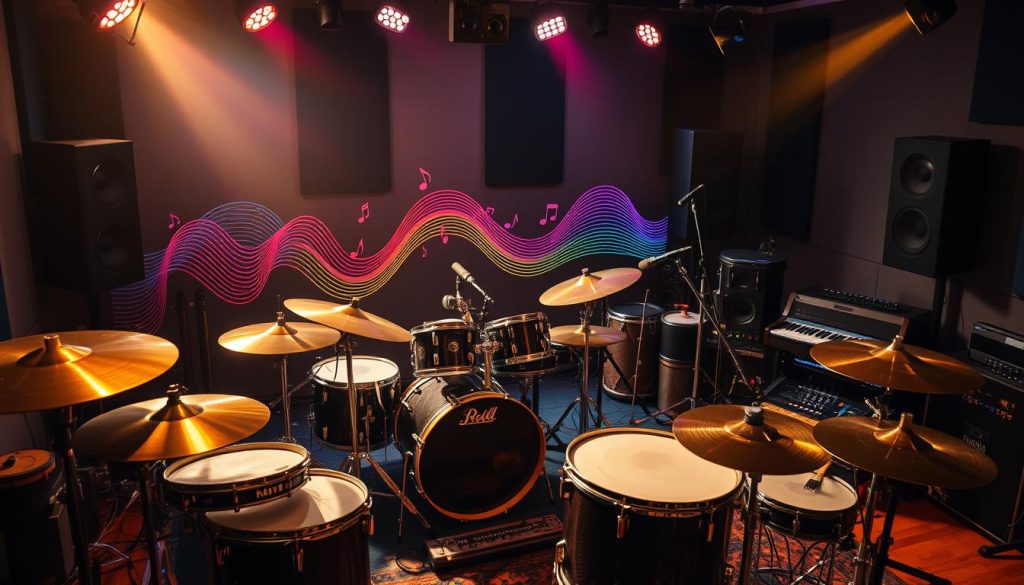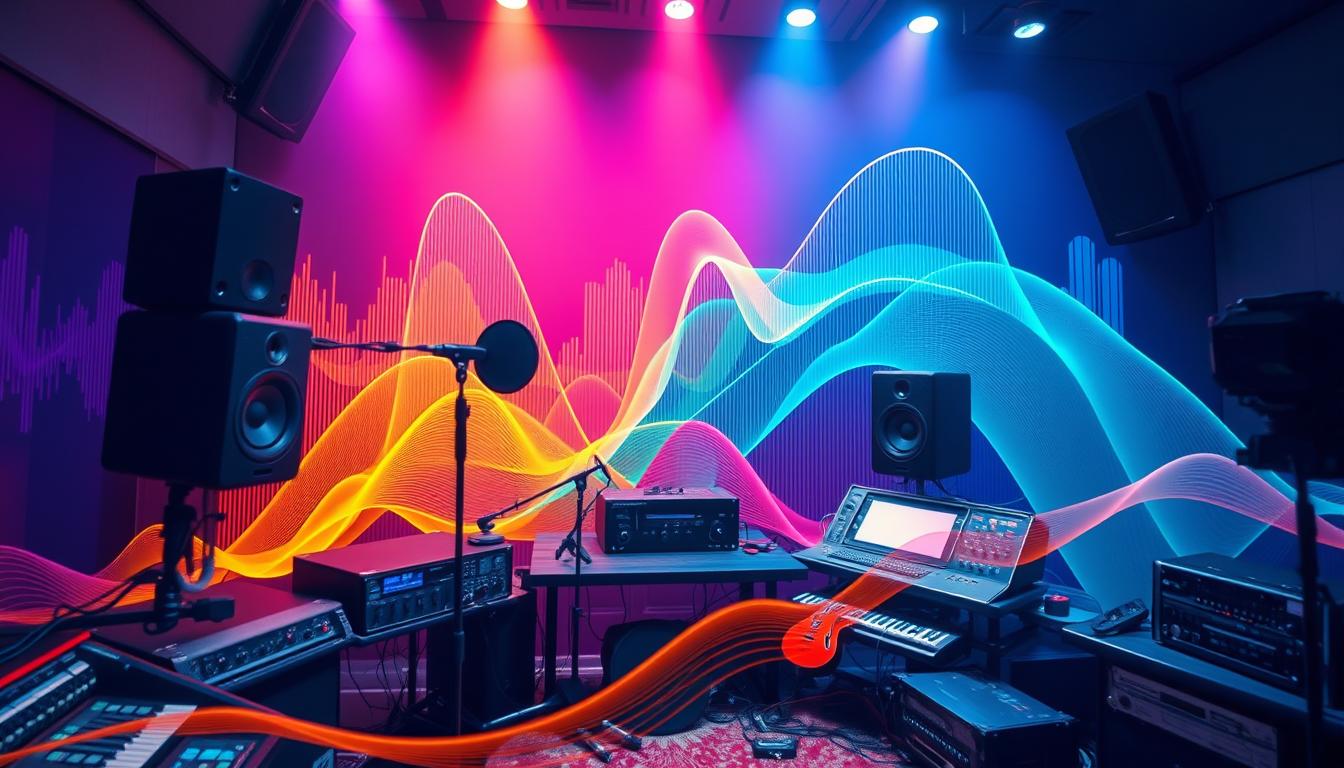I love the art of sound layering in music production. It lets us mix different sounds for a richer sound. By adding drums, synths, and natural sounds, we make our music deeper and more unique.
In this article, we’ll dive into sound layering. I’ll share tips and strategies to improve your audio production, sound design, and music production skills. These techniques are great for both new and experienced producers. They help add sonic depth and rich textures to your music.
Let’s explore the basics of sound layering. We’ll look at the key tools and setups you need. Then, we’ll move on to advanced techniques to elevate your music. Get ready to bring your creative ideas to life with layered soundscapes.
Understanding the Fundamentals of Sound Layering
For music producers, learning about sound layering is key. It means mixing different sounds together to make a richer sound. This method uses various sounds like synth patches and field recordings to make the music fuller and more interesting.
What is Sound Layering?
Sound layering is all about mixing different sounds together. It makes the music richer and more detailed. By adding sounds, producers can make the music feel bigger and more real.
Why is Sound Layering Important?
Sound layering has two big benefits. It makes your music sound bigger and more complex. It also lets you create a unique sound that makes your music stand out.
Learning how to layer sounds is a must for music producers. It opens up new ways to be creative and make music that grabs listeners.
Essential Tools and Setup for Professional Sound Layering
As an audio production enthusiast, I’ve learned that the key to sound layering is having the right tools and setup. A top-notch digital audio workstation (DAW) like Ableton Live or FL Studio is a must. It helps you organize, edit, and mix different audio tracks. You’ll also need EQs for adjusting frequencies, compressors for controlling dynamics, and spectral analyzers for seeing the sound’s frequency spectrum. Plus, high-quality studio monitors and headphones are key for hearing how sounds mix together.
To set up a pro sound layering setup, think about these key parts:
- A strong DAW software like Ableton Live, FL Studio, or Logic Pro for editing and mixing audio.
- A set of flexible sound design plugins, including EQs, compressors, and spectral analyzers, to tweak each layer.
- Top-notch studio monitoring gear, like studio monitors and headphones, to check the sound balance and layering.
- A MIDI controller or audio interface to connect hardware instruments and gear into your digital production.
With the right audio production tools and a well-set workspace, you’re ready to make captivating, multi-layered soundscapes.
Mastering the Frequency Spectrum for Cohesive Layers
As an audio producer, knowing the frequency spectrum is key. It helps me make sound layers work together well. Each sound has its own spot in the frequency range, from the low kick drum to the high cymbal.
This knowledge lets me adjust EQ settings and avoid clashes. This keeps the mix clear and clean.
Frequency Spectrum Basics
The frequency spectrum has different ranges: sub-bass, bass, midrange, and treble. It’s important to give each sound its own spot in the spectrum. This makes the mix clear and balanced.
By doing this, I stop sounds from stepping on each other’s toes. This makes the music sound better together.
Identifying Sonic Characteristics
Timbre and envelope also matter a lot in how sounds work together. Timbre is what makes each sound unique. Envelope controls how a sound changes over time.
Knowing these things helps me make sure each sound stands out. This makes the mix richer and more interesting.
Understanding the frequency spectrum and sound details is key for producers. With this knowledge, I can shape the sound, mix different timbres, and make music that grabs the listener.
Layering Drums and Percussion: Techniques and Strategies

Layering drums and percussion is key for music producers. It’s all about mixing different drum samples and hi-hat patterns. This creates a strong, engaging beat that grabs the listener.
Try layering different snare samples to make the beat richer. Adjusting the speed and timing of each hit adds depth. Adding small changes in hi-hat patterns also makes the beat more interesting. Using sidechain compression links the kick drum and sub-bass tightly. This makes the low end strong and punchy.
Layering Techniques for Dynamic Drums
- Experiment with layering different snare samples to add depth and richness to the backbeat.
- Incorporate subtle hi-hat variations to create a more intricate rhythmic tapestry.
- Use sidechain compression to tighten the relationship between the kick drum and sub-bass, resulting in a more impactful, dynamic low-end.
- Adjust the velocity and timing of individual drum hits to fine-tune the groove and enhance the rhythmic feel.
| Technique | Description | Benefits |
|---|---|---|
| Snare Layering | Combining different snare samples to create a unique, multi-dimensional backbeat | Adds depth, texture, and complexity to the rhythmic foundation |
| Hi-Hat Variations | Incorporating subtle changes in hi-hat patterns to enhance the overall percussive groove | Adds rhythmic interest and sophistication to the drum track |
| Sidechain Compression | Using sidechain compression to tighten the relationship between the kick drum and sub-bass | Results in a more impactful, punchy, and cohesive low-end |
Mastering drum and percussion layering makes tracks dynamic and engaging. It helps you stand out as a producer.
Layering Melodic Elements: Enhancing Harmonic Depth

Making melodies that grab your attention is an art. Adding a special touch makes them even better – melodic layering. By mixing synths, instruments, and sounds, I create harmonies that catch the listener’s ear and touch their heart.
Synth and Instrument Layering
In electronic music, layering is endless. I can start with a simple piano tune and add a lush synth pad. This adds depth and warmth. Or, I might mix a sharp synth lead with strings for a movie-like feel.
It’s important to think about how each sound fits together. By matching the sounds well, I make a rich sound that wraps around the listener.
Creative Sound Selection and Blending
Choosing the right sounds is key for a unique sound. I like to mix synthetic and real sounds, and different rhythms and textures. This makes a sound that’s both new and touching.
For instance, I might use a soft piano, a digital synth, and a mysterious pad. The mix of natural and synthetic sounds creates a beautiful, moving sound. It takes the listener to another world.
With melodic layering, I can take my music to new levels. I make sounds that are complex, full, and touch the heart. This leaves a strong mark on the listener.
Sound Layering: Advanced Music Production Techniques
Exploring advanced sound layering techniques can change the game for music producers. There are many strategies to make your mixes rich and dynamic. We’ll look at some top techniques to boost your music production skills.
Using stereo field manipulation is key. By placing sound layers across the stereo spectrum, you add depth and width. This includes double-tracking, panning, and using reverb and delay to make your tracks immersive.
Managing phase cancellation and gain reduction is vital. You need to make sure your layers work well together. Tools like dynamic EQ and saturation help blend layers smoothly.
Learning these techniques can unlock new creativity in your music production. They help you make tracks that grab your audience and show off your skills.
Leveraging Stereo Field Manipulation
- Double-tracking and panning techniques
- Creative use of reverb and delay effects
- Establishing a cohesive and immersive soundscape
Managing Phase Cancellation and Gain Reduction
- Understanding phase relationships
- Proper gain staging techniques
- Utilizing dynamic EQ and saturation for seamless blending
| Advanced Layering Techniques | Music Production Tips | Sound Design Strategies |
|---|---|---|
| Stereo field manipulation | Phase management | Specialized processing |
| Panning and double-tracking | Gain staging | Saturation and dynamic EQ |
| Reverb and delay integration | Blending and cohesion | Depth and width creation |
Creating Spatial Depth with Stereo Field Manipulation
Learning how to play with the stereo field changes everything in audio mixing. It lets me add depth and dimension to my tracks. By moving sounds around in the stereo space, I make the music wider and more engaging.
I use smart panning to make tracks sound deeper and clearer. By placing sounds on the left and right, I create space. This stops the mix from getting too busy and lets listeners enjoy every detail.
Reverb is another great tool I use. Adding reverb to certain sounds changes how far away they seem. It makes the music feel deeper and brings everything together smoothly. This creates a full, three-dimensional sound.

